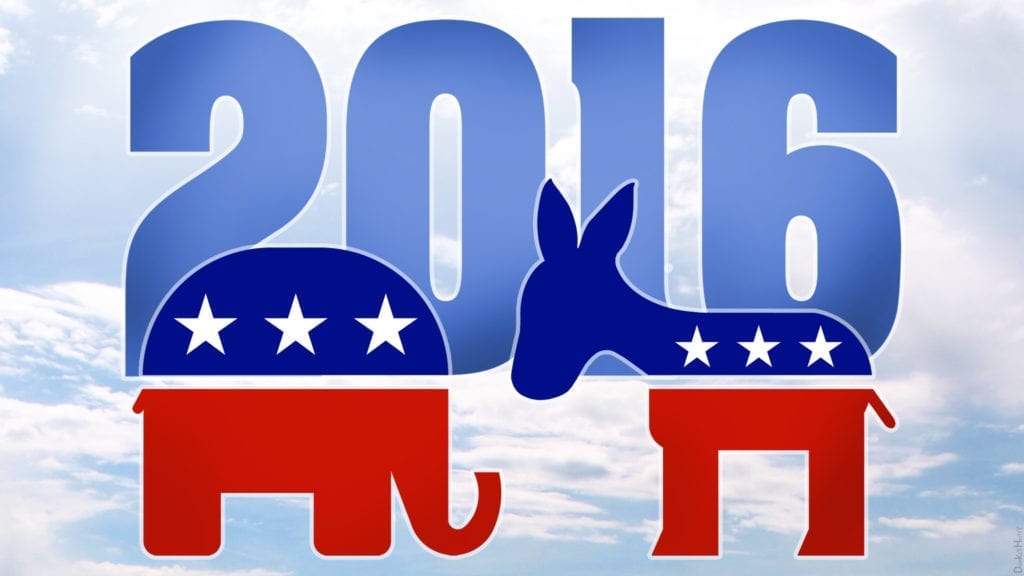Clinton vs. Trump: Paid Family Leave
In the first part of a five-part series analyzing each Presidential candidate’s policies, Samantha Lindsay dissects Hillary Rodham Clinton and Donald J. Trump’s stance on paid family leave.

https://www.flickr.com/photos/donkeyhotey/24101702220/in/photolist-CHMwo1-JJBqbo-JfqXJj-HtipDo-EmeBfD-q2LvvN-4EjNgb-hmzdu9-pFhzks-q4cpTN-rfqjvv-qb6LLi-q4cTcY-hFgVz7-hFhnAV-HPBQTn-fw4bh2-qXV8Bc-H9ycLj-j4Mzc2-qTskgB-DGFjYr-jc1Ah1-DdGiqr-E7VzQR-qFKZcy-pvL18H-aK7mXD-E7VA8z-CKwfkh-rMrUHE-rBeoWw-dhh6C5-rPZNZd-s7s6xE-dfrMXk-DuGv5d-DajVcb-fw4bfZ-GfbhE9-q3yPGu-oykALh-HV12FW-qb5h4H-CKwgN7-EfaRhe-jP8E6c-nWr2DW-DUbqVj-rQ8WnK
Written by Samantha Lindsay
The following report is the first in a five-part series offering a comparative analysis of select legislative proposals presented by the two major candidates in the 2016 presidential election; Democrat (D), Hillary Rodham Clinton, and Republican (R), Donald J. Trump. This series is not an endorsement of either candidate. Each installment will alternately begin with a policy analysis of one party followed by a similar analysis of the opposing party. Part one will cover the proposals of both candidates on the issue of paid family leave. This report will include a description of how these proposed legislative acts may benefit the voter, how the candidates intend to fund them, and will conclude with the major objections to these specific proposals.
According to a report by PBS NewsHour’s Lisa Desjardins, seen here, “paid family leave gets the support of over 70% of Americans over age 40, and that’s the same group that gets the highest turnout in elections.” Therefore, it should come as no surprise that both major candidates have made history by offering similar policy proposals on this issue. However, while both candidates support paid family leave, the details of their proposals present clear distinctions between the candidates.
(D) Hillary Rhodam Clinton
Clinton proposes legislation that would “Guarantee up to 12 weeks of paid family and medical leave to care for a new child” (hillaryclinton.com). Clinton’s program would offer employment protection to working mothers and fathers by requiring employers to put their jobs on hold while either or both parents take time off to care for a new infant. Further, it would guarantee that parents receive a paycheck equal to up to two-thirds of their wages while on leave, thereby minimizing the cost to parents of caring for a new child.
While Clinton does not offer specifics regarding how she intends to pay for this legislation, her website states that she will, “Fund paid leave by making the wealthy pay their fair share.” Clinton further promises that her proposal would, “impose no additional costs on businesses, including small businesses” (hillaryclinton.com).
There are four primary objections to Clinton’s proposal; the first of which is the lack of specificity.
Her website does not offer details regarding who will pay for the program or how much the legislation would cost. Who are the “wealthy” that she would tax and, what does she mean by “fair share”?
Second; while she has promised that her plan would lead to no additional cost to businesses, many business owners could be defined as the wealthiest Americans that she has said she would tax to fund the program. Therefore, while businesses may not directly fund the legislation, business owners would in the form of a tax increase.
Third; many businesses would be in the position of having to hire (and pay for the training of) temporary replacements while their employee is out. Alternatively, businesses would suffer the cost of decreased production if they are unwilling or unable to pay the cost of training temporary employees. This potential cost has led many to theorize that Clinton’s proposal might lead to employment discrimination for female workers during their child-bearing years. The same risk may apply to men who might become fathers during their time of employment because the benefit would be applied universally.
Finally; since Clinton’s proposal would benefit both men and women the cost to the taxpayer (regardless of who that taxpayer may be) would be at least double the cost of legislation that only covered paid family leave for female employees following the birth of a child.
(R) Donald J. Trump
Trump’s proposed legislation would “enhance unemployment insurance (UI) to include six weeks of paid leave for new mothers so that they can take time off of work after having a baby” (donaldtrump.com). The benefits of Trump’s proposal for families, while more modest and primarily focused on women, are similar to the potential benefits of Clinton’s proposal. Employers would be required to place a woman’s job on hold while she spent time off caring for a new infant. Additionally, as Daniel Halper of the New York Post explained in his September 14, 2016, article, Trump’s proposal would “guarantee that a mother on leave after having a child would get a paycheck for six weeks.” While Trump’s proposal is similar to that put forth by the Clinton campaign, there is a sharp distinction drawn in the means by which Trump plans to pay for his proposed legislation.
On his website, Trump lays out a varied and precise funding recommendation to cover the cost of his plan. He proposes the creation of a tax-free dependent care savings account (DCSA), “established for the benefit of specific individuals, including unborn children.” This savings account could be contributed to by parents, immediate family members, and employers. For low-income households, deposits would be matched by the government, thereby incentivizing savings. The plan would further implement unemployment insurance reform which would include a temporary benefit allowing for six weeks of paid leave for new mothers.
As stated on Trump’s website, “This cost could be offset through changes in the existing unemployment insurance system, such as by reducing the $5.6 billion per year in improper payments.”
There are four primary objections to Trump’s proposal. First, if DCSA does not require mandatory participation (and Trump’s website does not specify), many may opt out. That would mean that the entire cost would be covered by the new unemployment benefit. If participation is mandatory, then it amounts to a type of tax increase, though the individual tax-payer would be the direct beneficiary.
Second; adding a benefit to unemployment insurance may lead to a business tax increase if the administration is unable to offset the cost of the legislation.
Third; the same cost to business applies as in the Clinton proposal. Specifically the cost to business of hiring and training temporary employees or accepting the cost in production loss, which carries the potential of putting women in their childbearing years at risk of employment discrimination.
Finally; the lack of a universal unemployment benefit following the birth of a child in Trump’s plan doesn’t take into account that men are often the primary caregivers of their children.
Clinton vs. Trump
Comparatively, the strength of Clinton’s plan is that it is less discriminatory than Trump’s proposal and would offer greater flexibility as it would cover paid family leave for up to three months vs. Trump’s proposal that would only cover six weeks. The primary strength of Trump’s more modest program is that it would cost an estimated quarter of Clinton’s plan. Finally, while both ideas may put women in their childbearing years at risk of employment discrimination,Trump’s plan may decrease that potential risk with both the DCSA savings account and the time involved.
Edited by Ben Webb
Featured image by DonkeyHotey on Flickr, obtained using creativecommons.org



